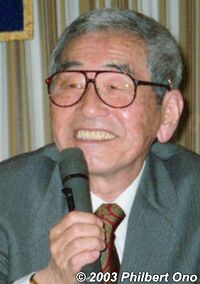NAGANO Shigeichi
NAGANO Shigeichi 長野 重一 (1925.3.30- ) Oita, Oita Pref. Acclaimed documentary and street photographer of urban scenes in Tokyo.
Major themes Tokyo street scenes
Education Graduated from Keio Univ. in Economics in 1947
Career Had planned to become a normal white-collar worker and did not intend to become a photographer until a chance meeting with NATORI Yonosuke through MIKI Jun. Both were graduates of the same university.
Natori hired him as an editor for the newly-launched magazine Sun News in 1947. Observed top photographers such as KIMURA Ihee, FUJIMOTO Shihachi, and INAMURA Takamasa on location. Left in 1949 to become a photographer for the Iwanami Shashin Bunko series, and traveled all over Japan to take documentary pictures for over 60 volumes in the series.
After taking purely objective photographs for informational purposes, he began to become more subjective with photography. His pictures began to reflect his own viewpoint and subjective response. Turned freelance in 1954. Involved in the filming of the Tokyo Olympics for the documentary movie directed by ICHIKAWA Kon.
Best known as a street photographer of urban scenes in Tokyo. He hunts for images while placing an emphasis on the current times and what he feels is the "now" of the time. His "Japan Dream Age" series of the 1960s and the "A Strange Perspective" series of fleeting scenes of Tokyo in the 1980s-90s are prime examples. Some of these photos can be seen in the exhibition catalog, A Chronicle of Japan. (2000.12.16)
Awards Camera Arts Award and Artist Award, Japan Photo Critics Association, 1960; Ina Nobuo Award, 1986; Award of the Year, Photographic Society of Japan, 1991; Medal with Purple Ribbon, 1993; Award of the Year, Photographic Society of Japan, 1995.
A Chronicle of Japan - この国の記憶
 Reviewed on: Dec. 16, 2000
Last modified: 2005-04-03
Reviewed on: Dec. 16, 2000
Last modified: 2005-04-03
Excellent collection of documentary and street photos of Japan taken during 50 years after the war.
理想的な展覧会カタログ兼写真集である。値段が安い、写真が多い(175点)、英訳が良い、そして一般の書店にも販売している。写真も分かりやすくて面白い。 学校の教科書になってもいい。
Published: June 20, 2000 Publisher: Nihon Shashin Kikaku ISBN: 4930887283 Price in Japan: ¥2,300 Qualities: Hard cover, B/W photos Size: B5, 159 pp. Language: Japanese and English
This book also served as the exhibition catalog for the photographer's major exhibition at the Tokyo Metropolitan Museum of Photography from June to Sept. 2000. It is an excellent introduction to this important photographer. The book is what I would call an ideal photo book/exhibition catalog. It's compact, light, and cheap, yet it offers many photographs (175) on glossy paper and a good English translation to boot.
Although the book is an exhibition catalog for the museum, the publisher is a private company. Therefore, the book is also sold by bookstores in Japan, which is good. The museum's previous exhibition catalogs, all published by the museum, were available only during exhibitions and at the museum's gift shop. I hope this photo book/exhibition catalog distribution strategy continues. It's such a waste to produce beautiful exhibition catalogs only to be bought by a very limited number of people. Wider distribution channels are definitely desirable.
The book does not contain all the 259 photographs that were shown at the exhibition. Missing from the book are the photographs that were taken overseas such as in Hong Kong and Berlin.
The photographs in the book are divided into four series. The first, titled "A Chronicle of Japan," are pictures of Japan during the immediate post-war years. This is a valuable photographic record of Japan as it recovered from the war. There's a picture of an army jeep passing by the Tokyo PX (Wako building) in Ginza, an MP directing traffic in Ginza in front of a battered Mitsukoshi Dept. store in 1946, graffiti (in English) scrawled by US soldiers on a wall of the famous Atomic Bomb Dome in Hiroshima in 1952, children sitting in a rickety wooden classroom on Rishiri island (Hokkaido) in 1956, and other images of the 1940s and '50s.
The next section, "Once Upon a Time in Tokyo," show scenes of Tokyo that you no longer see today. There's a fish monger's little boy holding a large fish (cover shot), people boarding a streetcar in Ginza, the skeleton of Asakusa Temple under construction, two young waitresses crossing the street to deliver meals, and two young girls with rolled up skirts wading through flood waters near home. This series is another important historical record of Tokyo.
Then we have "Japan's Dream Age" which is one of my favorite series. It is about Japan's high-growth period in the 1960s which brought both joy and sadness. There's a comical picture of several men peering at a new car at the Tokyo Motor Show in 1960, packed commuters in a train, a riot against the US-Japan Security Treaty, brides in wedding kimono coming and going at a wedding hall, a row of female factory workers stretching at their seats during an exercise break, people crowding around a TV set in a restaurant (with a sign saying "TV here") to watch a pro wrestling match, Japan's first danchi (public housing complex) in Tokyo in 1961, remnants of a closed mining town in Fukuoka, and people wearing aloha shirts in the Joban Hawaiian Center (a large hot spring bathing facility).
The last section called "A Distant Gaze/Happy Days in Tokyo" are random images of things that caught his eye. It's kind of like Araki's pcitures.
All the photo captions have been translated into English. Unfortunately, there is no English translation of Nagano's interview in Japanese at the end of the book. (Reviewed by Philbert Ono)
